Chapter 2. LAB 2 Laboratory Skills II: Microscopy and Histology
Learning Goals
- Know the basic evolutionary history of plants and characteristics of the major clades (i.e. groups).
- Know the traits plants evolved that allowed them to adapt to and colonize land.
- Know basic angiosperm plant structure and how to recognize their stunning variations.
- Understand how angiosperm plant structures relate to function.
- Apply basic knowledge of underlying plant structure to the identification of plant organs no matter how unusual or unfamiliar the organs may be.
Lab Outline
Activity 1: Microscope SALI
Activity 2: Angiosperm Anatomy and Reproduction
2A: Roots, Stems, and Leaves
2B: Modified Plant Organs
2C: Flower Dissection
2D: Fruit Adaptations for Dispersal
2.1 Scientific Inquiry

Leaf veins are part of the plumbing pipe system of vascular plants. Venation has two main purposes, veins provide structural support using lignin-fortified xylem, and form the transport system for water, nutrients, and hormones. Studies of vein density in leaves (mm of vein per square milliliter of leaf) have shown that there is a relationship between vein density and parameters such as leaf shading, soil water availability, light illumination, nutrient deficiency, and leaf size. For example, plants in tropical rainforests where precipitation is abundant tend to have high vein densities relative to plants in deciduous forests. However these relationships are not this simplistic, for example smaller leaves on the same tree may tend to have a higher vein density than the larger leaves on the same tree, but this correlation may not be true for all the trees of the same species within a population (Roth-Nebelsick et al. 2001).
Previously published evidence has shown that the number of veins in a plant positively correlates with the rate of carbon assimilation (i.e. sugar production) in photosynthesis and loss of water via transpiration. Researchers have also measured leaf-transpiration across taxa and noted a significant positive relationship between the rate of water conductance in the leaf and the vein density. These adaptations are thought to be one of the main evolutionary driving forces for the success of angiosperms on earth compared to other plant groups.
Boyce et al. (2009) investigated leaf vein density and its possible photosynthetic benefits in different plant groups using published data, fossil data, and fresh leaves (Figure 1). Compare the difference in leaf vein density between angiosperms and non-angiosperm plants. They noticed that the average vein density for non-angiosperm plant groups including ferns and gymnosperms was about 2 mm/mm2, while the average for angiosperms was 8 mm/mm2. Rarely did non-angiosperm leaf vein densities exceed 5 mm/mm2.
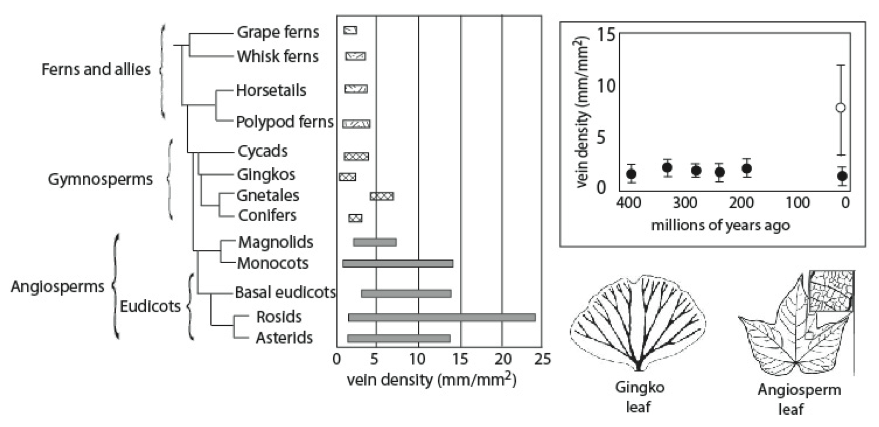
What other studies could be used to support the published literature and the study by Boyce et al. 2009? Would you expect there to be a relationship between stomata density in plant leaves as a function of vein density? As you learn about angiosperm anatomy in today’s lab, think about how studies like these were conducted. How might you conduct a study on angiosperms that can be related to issues of climate change, greenhouse gasses, and world-wide carbon assimilation?
2.2 Background
Land plants are also known as embryophytes because the “embryo” is protected by parent-derived tissue. Embryophytes form monophyletic groupings (i.e. clades) based on current data. They are naturally placed into five clades, the Bryophytes, Lycophytes, Pteridophytes, Gymnosperms, and Angiosperms, with Angiosperms being the most modern member. These five clades can be simplified into two major groups, nonvascular plants (Bryophytes) which include the liverworts, hornworts and mosses; and vascular plants (Tracheophytes) which include the remaining four clades.
The earliest green plants were the “green algae”. Plants made the transition from the entirely aquatic life of green algae, to life on land. This transition to land occurred during the Ordovician, about 400 mya (million years ago) when specialized adaptations made it possible for plants to live outside of water (Niklas K 1996, Figure 2). Making the move onto land introduced several new problems that were not faced by the green algae ancestor. How did the land plants evolve to endure the stresses of life on land (Table 1)? The phylogenetic tree of plants contains important evolutionary traits called synapomorphies that are related to their success on land (Figure 2 and Table 1). The earliest land adaptations included a water resistant, hence water retaining, cuticle. Modern bryophytes (mosses and liverworts) are living examples of plants with this adaptation. These groupings of plants were small and lacked vascular tissue for conducting water and nutrients and they reproduced with tiny spores.
Table 1 Land Plant Adaptations

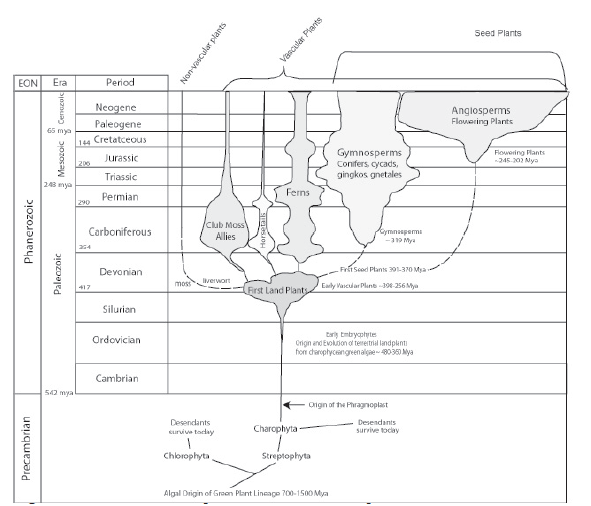
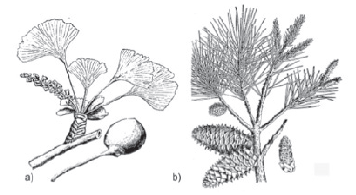
Later, in the Devonian, vascularized plants made their appearance in the fossil record: Specialized tissues for conducting water called vascular tissue make it possible for plants to move water from underground to plant tissues above ground. The first vascularized plants are represented by club mosses (L), horsetails (H), and ferns (F). But the most successful plants are vascular, seed-bearing plants. Seed-bearing plants are the prominent group of plants that dominate the land today and they are divided into the gymnosperms and the angiosperms. Gymnosperms (G), which means naked seed, made their appearance in the Carboniferous with seeds and pollen, both resistant to desiccation (Figure 2). The major groups of gymnosperms include the cycads, gingkos (Figure 3A), gnetophytes, and conifers (Figure 3B). The cycads are palm-like plants of the tropics and subtropics and can grow up to 20 meters high. There are still about 300 living species of cycads. The most abundant gymnosperms are the conifers with 700 species while the least abundant is the ginkgo with only one species. After the gymnosperms, late in the Mesozoic (Age of the Dinosaurs), the angiosperms (A) or “flowering plants” became abundant.
Angiosperms
The angiosperms are a highly successful plant group and can reproduce and disperse their seeds under a wide range of conditions. Many angiosperms are still wind pollinated like the gymnosperms but for many angiosperm species their flowers are modified to attract animal pollinators and their fruits are modified to attract animals who subsequently become seed dispersers.
The angiosperms are a large monophyletic group that can be further split into clades. Two major angiosperm clades are the monocots and the eudicots or dicots where the suffix “cot” in these groups refers to the cotyledons, or embryonic leaves of seed plants. Monocots have a single embryonic cotyledon while eudicots have two. Seeds are ripened ovules of plants that developed from a fertilized egg in the female plant and a pollen grain from a male plant.
Monocots (Figure 4) usually have leaves with parallel veins, but eudicots have a network of veins usually branching from a central vein. Grasses, palms, lilies, irises, and orchids are a few known monocots while many trees and cultivated plants are dicots. Dicots are known to be the largest angiosperm group and may undergo secondary growth unlike the monocots whose predominant growth mode is primary growth.
All plants, regardless of their phylogenetic classification, live by harvesting energy from sunlight and by collecting water and nutrients from the soil and the atmosphere. They have structures that enable them to perform photosynthesis to convert sunlight into chemical energy of bonds between atoms to produce products such as ATP, NADPH (i.e. reducing power), and sugars.
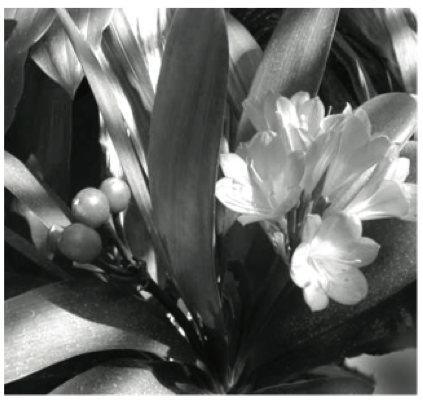
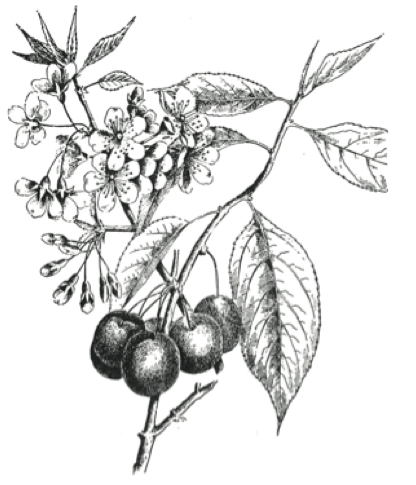
Plants that are members of the angiosperm group have four basic structures, roots, stems, leaves, and flowers. These structures allow the plant to perform photosynthesis and other functions necessary to survival like food and nutrient transport and reproduction. But have you ever observed a plant closely to see how its detailed features help it survive? Have you ever wondered why leaves are flat and grapevines climb? Even though plants appear to be simple organisms, they can have very intricate structures that vary from plant to plant.
Today’s plant anatomy lab will help you learn the structures commonly found in major plant groups. Once you have some familiarity with these basic structures we will introduce you to structural variations of basic plant organs that help the plant adapt to different habitats. You will explore these structural variations in considerable detail in the Greenhouse next week.
Roots, stems, and leaves assist plants in obtaining energy and producing food. The roots of a plant are responsible for anchoring the plant in the soil, absorbing water and minerals, and producing certain hormones. Some roots are also known as the storage organs of a plant due to their ability to store great amounts of water and nutrients. The stem of a plant holds the leaves or flowers and transports and distributes materials among the other organs of the plant. The leaves are the main sites for photosynthesis. Leaf cells contain chloroplasts the organelles that perform the important biochemical process of photosynthesis.
Living structures in plants like leaves and roots have readily understandable functions but there are many plant adaptations that we are still learning about. Based on what is known about plant structures, we can hypothesize about the function of spines on cacti, or imagine how the features of palm trees make them so well adapted to tropical islands. Science plays a special role in these speculations—science “tests” our hypotheses and defines which of them are supportable with evidence and which are unsupportable. You will have an opportunity to develop hypotheses about plant adaptations in the next lab, but in this lab you will acquaint yourself with plant groups, evolutionary traits, and angiosperm anatomy and reproduction. You will gain the skills in this lab to help you to scientifically ask and address questions about plant adaptations. You will also discover how your understanding of angiosperm structure can provide you with evidence for trends in plant evolution.
2.3 Resources
Bessette AE and Chapman WK. 1992. Plants and Flowers: 1761 illustrations for artists and designers. Mineola: Dover Publications, Inc.
Boyce CK, Brodribb TJ, Field TS, and Zwieniecki MA. 2009. Angiosperm leaf vein evolution was physiologically and environmentally transformative. Proc. R. Soc. B 276: 1771-1776.
Niklas KJ and Kutschera U. 2010. The evolution of the land plant life cycle. New Phytologist. 185 (1): p27-41.
Roth-Nebelsick A, Uhl Dieter, Mosbrugger V, and Kerp H. 2001. Evolution and function of leaf venation architecture: A review. Annals of Botany 87: 553-566.
2.4 Lab Preparation

Watch the vodcast and read this lab. Write all notes in your lab notebook. Visit the BLC and complete a SALI on the compound microscope. There will be a Lab Quiz on this information.
2.5 Activity 1: Microscope SALI
Learning Objectives
After successful completion of this activity, you should be able to:
- Apply a SALI to a new and unfamiliar piece of lab equipment (LO16)
- List criteria stating when it is appropriate to view a specimen under the dissecting microscope versus the compound microscope (LO19)
- Make a wet mount of plant epidermal tissue (leaf peel or onion skin) without air bubbles(LO20)
- Demonstrate the terms “field of view” and “depth of field” with a specimen and different compound microscope objective lenses (LO21)
Materials
Dissection kit (provided by student)
Microscope slides, coverslips, lens paper, and cleaner
Dissecting microscope and lamp
Compound microscope
Plant Histology Stains
IKI stains starch blue-black to blue
Phloroglucinol stains lignin of xylem red
Toluidene blue stains living tissue purplish (nonspecific stain)
Methylene blue stains living tissue bluish (nonspecific stain)
Letter “e”
Plant specimens
2.6 Procedure
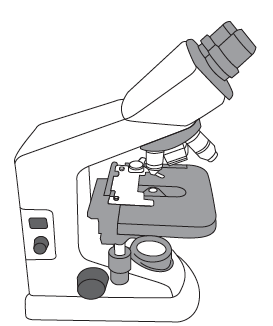
- Based on the information in the Appendix and the SALI method, properly take two compound microscopes (Figure 6) and two dissecting scopes from their cabinet for everyone in your group. Pair off in subgroups of two with one of each microscope per two students.
- Take two letter “e” slides and two prepared slides of plant tissue for your group.
- Discuss the microscope SALI as a class to review the important safety and handling features of your microscopes.
- View the microscope video and follow the steps in the video to learn the parts and proper use of the compound microscope with the letter “e” slide as your specimen. Your instructor will start and stop the video at each step for you to follow along.
- View the prepared plant tissue slide. How many plant cells are in your field of view with the 4X, 10X, and 40X objectives? Why does the number change? Based on what you see, draw the structure of a typical plant cell.
- Your instructor will test your ability to make and view a wet mount of plant tissue using the compound scope. Each of your subgroups will prepare a wet mount of a Tradescantia leaf epidermis.
- Peel back the epidermis from a Tradescantia leaf. Place a drop of water on a clean slide and use your forceps to transfer a small section of the epidermis to the water on the slide. Add a coverslip.
- Demonstrate to your instructor that you can properly focus the specimen with the correct lighting at 400X magnification.
- Answer the following questions about your Tradescantia leaf epidermis wet mount.
- How many cells are in the field of view?
- Locate the guard cells, accessory cells, epidermal cells, and stomatal openings. Sketch and label the guard cells.
- Estimate the number of stomata in a 1mm square area of the leaf epidermis. Where are stomata located in a desert plant like a cactus?
- Complete the following checklist to ensure that you are competent in microscope use. You will be tested on your ability to flawlessly use the compound scope and view and count cells during the “timed” competency exam.
- I know the safety issues in the handling of the microscope and the steps necessary to prevent harm to myself or others.
- I know the breakage issues in the handling of the microscope and how to avoid them.
- I can properly prepare a specimen and view it optimally at low and high magnification using the dissecting scope.
- I can properly prepare a wet mount and view it optimally at low and high power using the compound microscope.
- I can complete the microscope shut down procedure when finished with viewing specimens.
- I can properly clean the microscope lenses.
- Once you are comfortable with the use of both microscopes start Activity 2. During the lab, your instructor will use the checklist to spot test you on your ability to properly use each microscope.
2.7 Activity 2: Angiosperm Plant Anatomy and Reproduction
The most complex plants, the flowering plants (Angiosperms), are constructed from only four major organs—roots, stems, leaves, and flowers (Figure 7). They come in all sizes, shapes, and textures. Some organs may be reduced or expanded, yet the structural pattern is the same in all vascular plants. If you understand this pattern then you can easily identify plant organs, even when they are disguised as unusual shapes. For example, a white potato, which is a stem, has “eyes.” These are the nodes of the stem and contain leaf scars where the leaves once were attached; if you see nodes, you can be fairly certain that you are looking at a stem. Becoming familiar with the basic organization of plant anatomy will make your future observations of unusual plant structures easier to interpret and understand.
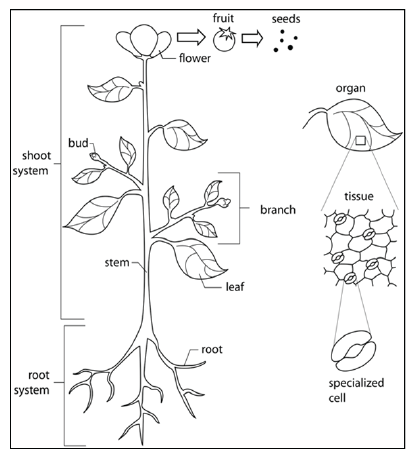
Work in subgroups of two people for Activities 2a–d and follow the directions for Subgroup 1 and Subgroup 2. Share your observations within your group as you proceed through each activity. In the following activities we will dissect plants and plant organs to gain a basic understanding of angiosperm plant anatomy. Develop your ability to convert between two dimensional images and three dimensional objects. All of the structures you observe in three dimensions can also be rendered in two dimensional cross section and long section. View fruits and seeds and interpret them from a functional perspective. Study different mechanisms of seed dispersal. Relate your knowledge of simple plant organ anatomy to other unfamiliar plants.
Materials
Dissection kit
Dissecting microscope and Compound microscope
Plant Histology Stains
Digital microscopes (capture images of plant specimens)
Plant tissues/organs and flowers
Fruits and seeds
2.8 Activity 2A: Roots, Stems, and Leaves
Learning Objectives
After successful completion of this activity, you should be able to:
- View gross plant specimens with the dissecting scope (LO22)
- Label a diagram of the parts of the shoot and root system of a plant (excluding cactus) (LO23)
- List or describe the function of leaves, roots, stems, and flowers (LO24)
- Locate the shoot and root system on living plant specimens (LO25)
- Produce an “identifiable” sketch of a plant or plant leaves, roots, stems, and flowers with appropriate labels (as viewed with or without the aide of a microscope) (LO26)
2.9 Procedure
- Bring your own plant specimen from home or the field. You can use it in this activity as well as activity 2B.
- As a group, identify the plant shoot (leaves and stems) characteristics in the potted Coleus, grass, and cactus plants provided, as well as the root characteristics in the grass provided. Use the lab pictures to aide you with your observations. Sketch and label your drawings in your lab notebook.
- Make observations of the Coleus plant (Subgroup 1)
- Remove a Coleus leaf and petiole (stalk) and view their structure under the dissecting microscope. Compare your observations with a monocot leaf (grass).
- Note any epidermal protrusions and the vein structure.
- Make a list of characteristics that differentiate the Coleus leaf from the grass leaf.
- If you had to collect data on these two plants, what might you count, measure, or describe that would help you characterize their differences?
- Make observations of the cactus (Subgroup 2)
- Dissect one cactus tubercle with the spine-containing areole and view the gross anatomy under the dissecting microscope. Your instructor will prepare cross sections of the cactus stem for you to view under the compound microscope.
- Make a list of characteristics that differentiate the cactus spine from the Coleus leaf.
- If you had to collect data on these two plants, cactus and Coleus, what might you count, measure, or describe that would help you characterize their differences?
- Share your observations with your other group members.
- As a group, share your observations. Describe the major differences between the Coleus and the cactus based on the four plant organs.
- Test yourself: Identify the major plant organs on the specimens that your group members brought from home or the field.
2.10 Activity 2B: Modified Plant Organs
Learning Objectives
After successful completion of this activity, you should be able to:
- Use a dissection kit to create translucent plant specimens for viewing under the compound or dissecting microscopes (LO27)
- Stain dissected plant tissue with nonspecific histological dyes (LO28)
- Stain lignin in plant tissue (LO29)
- Draw a cartoon of the arrangement of vascular tissue in the leaf, root, and stem for a monocot versus a dicot (LO30)
- Determine if an unknown plant or plant organ is a root, stem, or leaf or monocot or dicot based on its gross anatomical features or arrangement of its vascular tissue (LO31)
- List three plant organ modifications and their adaptive functions (LO32)
2.11 Procedure
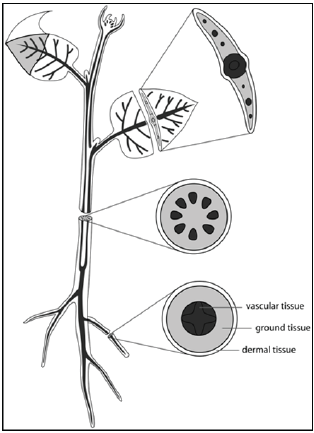
- Retrieve the laminated plant dissection sheet for your assigned modified plant organ as well as the modified plant organ. Modified plant organs may include succulent leaf (kalanchoe), onion, carrot, asparagus, broccoli, celery, and white potato.
- Sketch and label the gross anatomical characteristics of your modified organ. Note how its basic structures (root, stem, leaf, and flower) differ to perform specific functions for plant survival. Use Table 2 for hints and ideas.
- Dissect, in duplicate (one per subgroup), a slice of your plant organ that is thin enough for light to pass through (i.e. translucent). Stain your plant organ according to the directions on your dissection sheet.
- View the prepared slides under the dissecting microscope at the lowest and highest magnification settings in your subgroups but discuss your observations as a group.
- Sketch the position of vascular bundles and specialized tissue layers, vascular, ground, and dermal (Figure 8).
- Is this a stem, leaf, or a root based on your observations of the organ’s gross anatomy and your stained tissue dissection? Write the evidence for your answer in your lab notebook.
- Place your two prepared slides on top of the laminated plant dissection sheet and return the sheet with slides to the instructor bench for other groups to view. Repeat this process for two other modified organs that were prepared by other groups.
- Test yourself: Compare several challenge plants in the lab. Identify them as roots, stems, or leaves and provide evidence for how you distinguished them. Include your own specimens.
Table 2 Modified Plant Organs: Modifications to the size and shapes of leaves, stems and roots are so diverse that they have different names. The terms in this table are examples of structural modifications to these basic plant organs. When investigating these modified organs, you will see their underlying structures correspond to the corresponding structures of either roots, stems, or leaves.
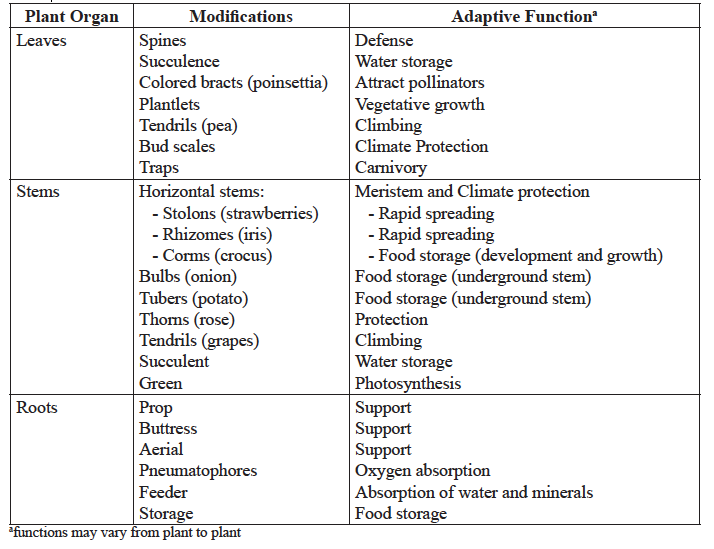
2.12 Activity 2C: Flower Dissection
Do plants reproduce sexually? Angiosperms produce flowers which house the male and female sexual organs, where the plant gametes are produced and stored. The flowers come in an astonishing array of colors, shapes and sizes. Although humans have cultivated many spectacular flower varieties, colorful and scented flowers arose naturally long before humans existed. Have you ever wondered how and why this tremendous flower variation evolved?
Learning Objectives
After successful completion of this activity, you should be able to:
- Locate the male (stamen) and female (carpel) reproductive parts on a living or preserved flower (LO33)
- Describe the relationship between floral parts and fruit after fertilization (LO34)
2.13 Procedure
- Obtain a flower from the flower station. Examine its external morphology noting the four whorls of flower parts (sepals, petals, stamen, and ovary). Which of these floral parts becomes the fruit after fertilization?
- Make a longitudinal cut in the flower, so you produce two halves similar to Figure 9. Give one half of the flower to each subgroup for viewing.
- Examine the male stamens (anther and filament) and female carpels (ovaries, style, and stigma) under the dissecting scope. Would you expect the position of the male and female parts to be conserved from flower to flower? Explain.
- (Optional) Brush pollen off of the anthers onto a microscope slide. Make a wet mount and examine under the compound scope.
2.14 Activity 2D: Fruit Adaptations for Seed Dispersal
Fruit are ripened ovary walls produced after fertilization and contain the plant embryo or seed. In order for a plant to survive, it must disperse its seeds to areas that are conducive to their germination and growth. Fruits are often modified to facilitate seed dispersal into areas distant from the parent plant. Some angiosperms have evolved fruits that are thin and blade-like, so that their seeds can be dispersed by the wind. Other angiosperms evolved fruits that are desirable food for animals. The seeds themselves are indigestible or are surrounded by an indigestible coat and pass through the animal’s digestive tract. Many fruits coevolved with animals, fostering feeding on particular fruit by specific species. For example, small birds commonly eat smaller fruits and seeds, whereas larger birds such as toucans or parrots eat larger, soft-skin fruit. Fruits with a husk that may have to be peeled away are often eaten by primates (Table 3).
Some plants have adopted fruit dispersal methods that seem strange or maladaptive. For example, angiosperms that produce nuts make inedible fruits but edible seeds—imagine making your own embryos edible! What makes this peculiar seed dispersal strategy successful? What selective pressures might favor an arrangement in which the progenitor plant is edible?
Learning Objectives
After successful completion of this activity, you should be able to:
- Place known seeds into categories based on modes of dispersal (LO35)
- Hypothesize the possible modes of dispersal for unknown seeds and devise methods to test your hypothesis (LO36)
2.15 Procedure
- Use a flat to bring to your lab bench fruits that are an example of each of the following:
- A fruit that is modified for wind dispersal of its seed.
- A fruit that is modified for external animal dispersal of its seed.
- A fruit that is modified for internal animal dispersal of its seed.
- As a group, compare and contrast the fruits by constructing a table in your lab notebook and recording observations for each. Include sketches.
- Note in your table or on your sketches the properties of the fruit that adapt it for a particular type of seed dispersal.
- List a few examples of fruit that you are familiar with that are not available in lab. Add your examples to your table.
- Discuss as a group and write in your lab notebooks thoughts on how you would go about determining the mode of seed dispersal for an “unknown seed”? What characteristics would you use or experiments would you perform to make this determination?
- (Optional) Locate the floral parts of the fruit that still remain with the fruit.
- Return the fruits to their original locations when you have completed your observations.

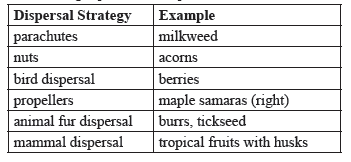
2.16 Self Assessment
These questions were taken from previous exams and are meant to represent a sample, not a complete study guide. The questions in these examples are designed to test your understanding of the concepts and skills presented in this lab, and your ability to apply what you have learned to novel problems.
1.
Computation: If you measure the diameter of the field of view for the 4X objective lens of a compound microscope with 10X oculars as 4.5 mm, what is the diameter of the field of view for the 100X objective lens? What is the magnification of a specimen viewed with the 100X objective?
2.
LOC: Which of the following adaptations serves to prevent water loss, overheating and predation in plants from arid climates?
| A. |
| B. |
| C. |
| D. |
| E. |
| F. |
3.

HOC: Deneen places the letters “MD” under the compound microscope. Which of the following did she most likely observe in the field of view?
| A. |
| B. |
| C. |
| D. |
| E. |